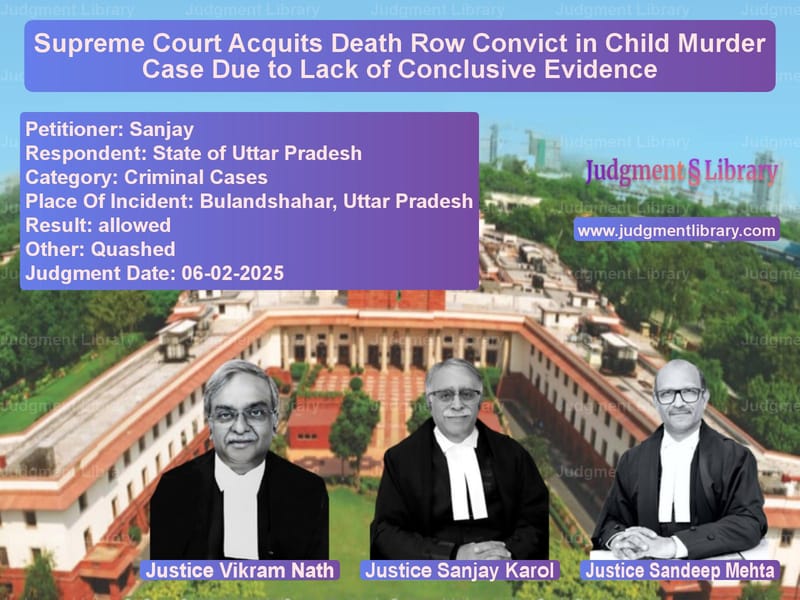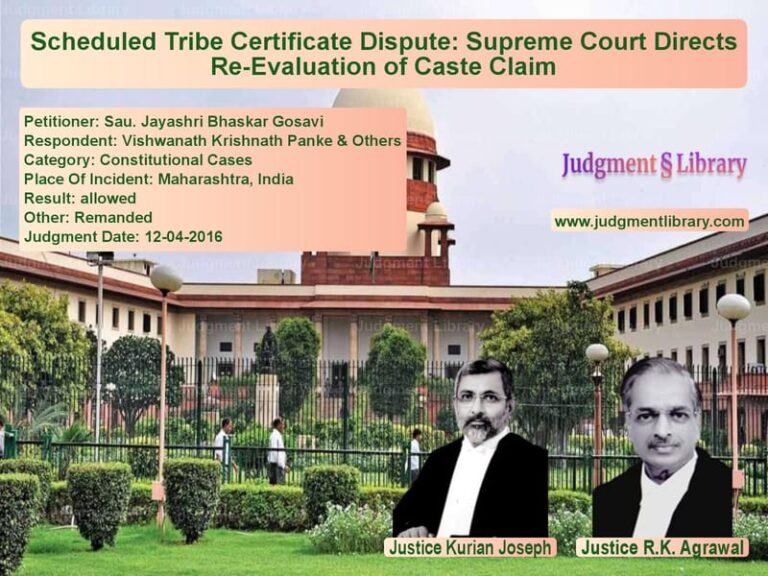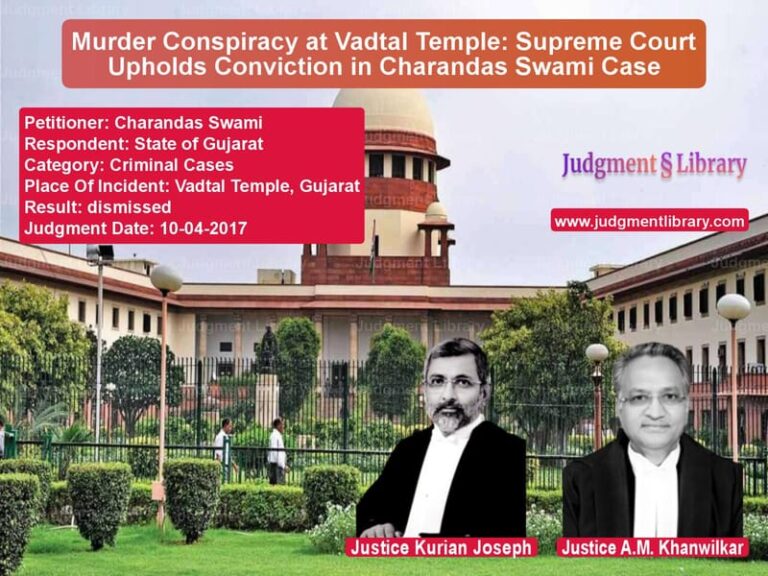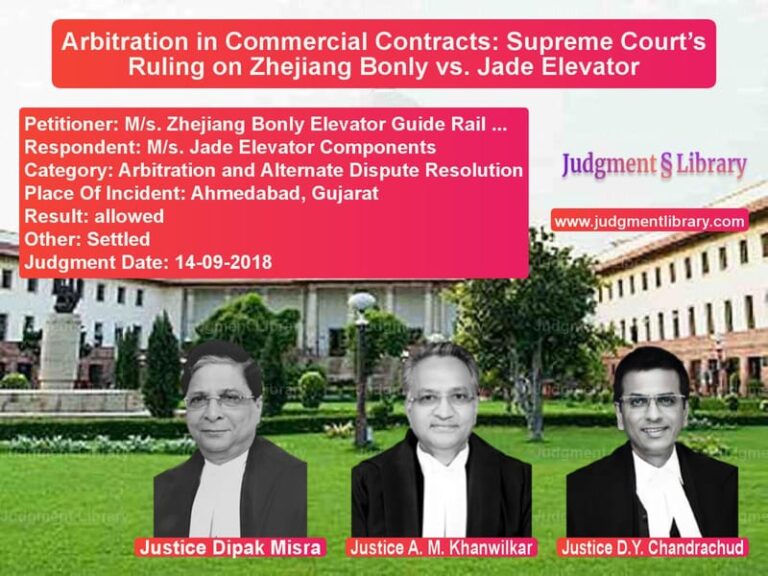Supreme Court Acquits Death Row Convict in Child Murder Case Due to Lack of Conclusive Evidence
In a significant ruling, the Supreme Court of India overturned the conviction of Sanjay, who had been sentenced to death for the alleged rape and murder of a four-year-old girl. The Court ruled that the evidence presented by the prosecution was insufficient to conclusively establish guilt, leading to the acquittal of the accused after spending years on death row.
Background of the Case
The case originated from an incident on April 22, 2004, in Bulandshahar, Uttar Pradesh. The accused, Sanjay, was charged with the rape and murder of a minor girl, referred to as ‘X.’ The prosecution alleged that Sanjay had taken the child from a marriage ceremony and later murdered her, disposing of the body in a sugarcane field.
Following an FIR lodged on February 28, 2004, the accused was arrested and reportedly confessed to the crime, leading to the recovery of the deceased’s body. The Trial Court convicted Sanjay under Sections 302 and 376(2)(G) of the Indian Penal Code (IPC) and sentenced him to death. The conviction was later upheld by the Allahabad High Court, prompting the present appeal before the Supreme Court.
Key Legal Issues
- Whether the circumstantial evidence presented by the prosecution established guilt beyond a reasonable doubt.
- Whether the alleged extra-judicial confession of the accused was voluntary and legally admissible.
- Whether the forensic evidence supported the prosecution’s claim of rape and murder.
Arguments by the Appellant
The appellant’s counsel argued:
- The conviction was based purely on circumstantial evidence, with no direct eyewitnesses to the crime.
- The accused had been part of the search party for the victim for six days, raising doubts about his culpability.
- There was an unexplained delay in lodging the missing person report, making the prosecution’s case doubtful.
- The extra-judicial confession was inconsistent, with witnesses providing conflicting locations of where the confession allegedly took place.
- The forensic report failed to conclusively link the accused to the crime.
“The entire case is based on weak circumstantial evidence that does not meet the legal threshold for a conviction, let alone a death sentence.”
Arguments by the Respondents
The prosecution and the State of Uttar Pradesh countered:
- The accused was last seen with the victim, which is a strong indicator of guilt.
- His extra-judicial confession led to the discovery of the deceased’s body, reinforcing his culpability.
- The victim’s clothing and other recovered articles matched the forensic evidence, supporting the prosecution’s narrative.
- The accused’s conduct and attempts to mislead the search party pointed to his guilt.
“The sequence of events and the accused’s confession conclusively establish his guilt in the heinous crime.”
Supreme Court’s Observations
The Supreme Court meticulously examined the case and found multiple inconsistencies in the prosecution’s claims:
- The accused’s presence in the search efforts for several days was inconsistent with the behavior of a guilty person.
- The delay in filing the missing person complaint raised concerns about the reliability of the prosecution’s timeline.
- Multiple contradictions existed in the prosecution witnesses’ testimonies regarding the location and timing of the extra-judicial confession.
- The forensic report failed to conclusively link the accused to the crime scene or establish the allegations of sexual assault.
- The last-seen theory, while relevant, was insufficient to sustain a conviction without additional corroborating evidence.
“A conviction cannot be sustained solely on circumstantial evidence unless it forms a complete chain pointing unequivocally to the guilt of the accused.”
Final Judgment
The Supreme Court ruled:
“The conviction under Sections 302 and 376(2)(G) IPC is set aside. The accused is acquitted of all charges, and his immediate release is directed unless required in another case.”
The ruling not only overturned the death sentence but also emphasized the need for higher evidentiary standards in cases relying solely on circumstantial evidence.
Impact of the Judgment
This ruling has critical implications:
- Reinforces the principle that death sentences must be based on unimpeachable evidence.
- Establishes stricter scrutiny for extra-judicial confessions in criminal cases.
- Highlights the importance of forensic corroboration in serious criminal offenses.
- Prevents wrongful convictions based on weak circumstantial evidence.
By acquitting Sanjay, the Supreme Court has upheld the fundamental legal principle that an accused must be proven guilty beyond a reasonable doubt, ensuring justice is served without wrongful convictions.
Petitioner Name: Sanjay.Respondent Name: State of Uttar Pradesh.Judgment By: Justice Vikram Nath, Justice Sanjay Karol, Justice Sandeep Mehta.Place Of Incident: Bulandshahar, Uttar Pradesh.Judgment Date: 06-02-2025.
Don’t miss out on the full details! Download the complete judgment in PDF format below and gain valuable insights instantly!
Download Judgment: sanjay-vs-state-of-uttar-prade-supreme-court-of-india-judgment-dated-06-02-2025.pdf
Directly Download Judgment: Directly download this Judgment
See all petitions in Murder Cases
See all petitions in Bail and Anticipatory Bail
See all petitions in Judgment by Vikram Nath
See all petitions in Judgment by Sanjay Karol
See all petitions in Judgment by Sandeep Mehta
See all petitions in allowed
See all petitions in Quashed
See all petitions in supreme court of India judgments February 2025
See all petitions in 2025 judgments
See all posts in Criminal Cases Category
See all allowed petitions in Criminal Cases Category
See all Dismissed petitions in Criminal Cases Category
See all partially allowed petitions in Criminal Cases Category







